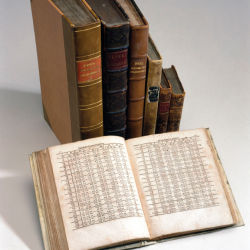
For some people it’s typewriters. For other people it’s mechanical calculating machines that bring a nostalgic tear to the eye. For me it’s mathematical tables. The sight—even the smell—of a set of four-figure tables transports me to my distant school and college days. You can still find mathematical tables—their yellowed pages filled with decimal digits and not much else-in secondhand book stores and occasionally on eBay. I once thought I might like to collect mathematical tables, but then I discovered from the Index to Mathematical Tables1 that many hundreds of tables have been published. Even a selective collection would prove burdensome, if not grounds for divorce. Ironically, the Index to Mathematical Tables, a monumental bibliographical endeavor, was published in 1962, just as tables were going out of business.
Mathematical tables were excruciatingly tedious to calculate. Take for example logarithmic tables, which ruled the calculating roost for about 300 years. Logarithms were invented by the great Scottish philosopher John Napier around 1614, and a practical table of logarithms to base 10, the Aritmetica Logarithmica, was calculated by the English mathematician Henry Briggs and published in 1624. While the logarithm was an invention of genius, computing them to 14 decimal places was assuredly a labor of Hercules. It is said that when Napier and Briggs first met “almost one quarter of an hour was spent, each beholding the other with admiration, before one word was spoken.”
Logarithms were so laborious to calculate that subsequent tables were not recomputed but were compiled from the existing canons. The raw logarithms would be reduced to four, five, six, or seven decimal places and conveniently arranged and printed using the best typography of the day. It is said that the most accurate table of logarithms ever produced was Charles Babbage’s seven-figure tables. Babbage was somewhat a connoisseur of tables and owned approximately 300 volumes. Like his predecessors, he did not recompute the logarithms but copied them from existing tables. Where there was a discrepancy in his sources he would recompute the offending entry. It was almost a literary exercise—an anthology of the best logarithms, so to speak.
But Babbage did produce some astronomical and actuarial tables from scratch. Babbage used computers for the calculations—not machines but human drudges, because “computer” was then an occupation, not a machine. It was while he was checking his astronomical tables that he made the oft-quoted remark “I wish to God these calculations had been executed by steam.” Shortly after, in 1824, he secured funding from the British government to build a “difference engine” for calculating tables (powered by hand, not steam). Babbage’s engine was a magnificent failure. He overdesigned, mismanaged, and nothing materialized except a prototype and some plans for a full-scale machine. Babbage’s difference engine was finally completed in 1991 at the London Science Museum, in time to celebrate the bicentenary of Babbage’s birth. Amazingly, it worked beautifully.
Although a few difference engines along Babbage’s lines were built in the second half of the 19th century, they tended to be fickle and expensive and there was no real market for them. So, for the first half of the 20th century most tables were produced by human computers, sometimes using a mechanical desk calculator or a punched card machine, but as often as not just plain pencil and paper.
The biggest human computing organization in the world was established in New York in 1938 and is described by David Grier in his remarkable book When Computers Were Human.2 The so-called Mathematical Tables Project was a depression-era, make-work project for Roosevelt’s Works Progress Administration. It was intended to employ out-of-work clerks and bookkeepers in the useful work of making mathematical tables. Most of the project’s human computers used nothing more than colored pencils and pre-printed calculating sheets. At its peak in World War II, the project employed 450 computers producing tables for the war effort. Table making was then a flourishing business. In 1943, a new journal-—Mathematical Tables and Other Aids to Computation—recorded the practical and theoretical advances being made.
Another massive wartime table-making project was established by the Moore School of Electrical Engineering, University of Pennsylvania, and the Ballistics Research Laboratory at the Aberdeen Proving Ground, Maryland. The war had created an unprecedented demand for “firing tables” for newly developed artillery and for existing weapons to be deployed in new theaters of war. A firing table provided the elevation and azimuth to enable a gun to be aimed with accuracy for a given target distance. A team of 200 female computers, equipped with mechanical calculating machines, helped to produce the tables. But this was not nearly enough computing power. Each firing table contained about 3,000 entries, and each entry took about one or two person-days to compute. Two Moore School academics, John Mauchly and Presper Eckert, proposed the construction of an electronic computer to perform these ballistics calculations—this was the ENIAC, the Electronic Numerical Integrator and Computer. Eckert and Mauchly got the go-ahead to build the ENIAC in spring 1943, although it was not completed until late 1945 and so was too late to help in the war effort. While ENIAC was not the first, it was certainly the most famous early electronic digital computer.
Before the ENIAC was finished, however, it was realized that although it could calculate ballistics tables to perfection, it was otherwise rather limited in the kind of computations it could perform. In the summer of 1944 the Princeton mathematician John von Neumann learned of the ENIAC, and worked with the Moore School team to design a better machine. Dubbed the EDVAC, for Electronic Discrete Variable Automatic Computer, it was a design of such versatility that its architecture has underpinned computer design ever since. It became known as the stored-program computer.
In the 1950s the new stored-program computers started to proliferate. Suddenly table making was made easy. Among other computational tasks, computers began to grind out tables as never before. We can see from the Index of Mathematical Tables that in the 1950s more tables were published than in any previous decade. But of course, if you had access to a computer you no longer had much need for mathematical tables. For example, trigonometrical and hyperbolic functions could be computed using a simple subroutine to compute values on-the-fly in the course of a program.
At first it was not entirely clear whether computers would stimulate the production and consumption of tables or eliminate them entirely. An aging generation of table makers clung to the former hope. But the writing was on the wall. By the end of the 1950s, most big academic and research institutions had a computer, and it was clear that by the end of the 1960s they all would. In the late 1940s Mathematical Tables and Other Aids to Computation had become the journal of record of the ACM, but it seemed like the tail was wagging the dog and in 1954 ACM launched its own Journal of the ACM. In 1959 Mathematical Tables and Other Aids to Computation bent to the wind and renamed itself the Mathematics of Computation. Over the next two decades the publication of new tables slowed to a trickle.
Four-figure tables still found a place in school and undergraduate studies, but the advent of the electronic calculators in the 1970s finally put an end to them. I recall an occasion in 1990 when I saw in a thrift store a two-foot-high stack of brand-new four-figure tables. On inspection it turned out they were printed in 1978. I suppose they had been stored for a decade in the publisher’s warehouse and had now been remaindered—with one last stop in a thrift store before finally being pulped. I was powerless to prevent their fate, though I rescued one for my bookshelves for the princely sum of 10 pence.
It is one of the great ironies of computing that in the 1950s what all go-ahead table makers wanted was a digital computer, but within a decade the computer had made both them and their tables obsolete. As a wise man once cautioned, “be careful what you wish for.”




Join the Discussion (0)
Become a Member or Sign In to Post a Comment